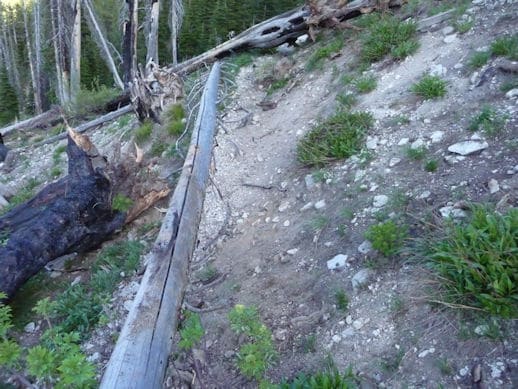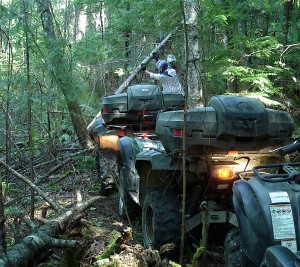
by Bill Uhl © 2019 Expert Witness, Safety Trainer & Trail Builder
Recreationists and workers can’t count on someone else ensuring our safety when we’re using mountain trails. As a Court-Qualified Expert Witness, Safety Trainer and trail builder / maintainer, I’ve worked on over 76 legal cases and provided testimony regarding the operation of all-terrain vehicles -- ATVs, UTVs, snowmobiles, as well as motorcycle dirt bikes, dual sport motorcycles, street bikes, off-road guided tour injuries and related trail construction issues. During a 16-year period of time, I completed over 54 miles of recreational trail heavy maintenance, trail building and thousands of miles of light maintenance.
I’m often asked by both plaintiff and defense attorneys to explain how to properly build and maintain trails. They also ask me how to prevent accidents and injuries for all users, including operators of off-highway vehicles (OHVs), such as quads, quad bikes, four wheelers) utility vehicles (side by sides, ROVs, RZRs), mountain bikes and the motorcycles mentioned above. I’m also asked to consult concerning guided tour customers who have sustained injuries.
This article addresses a recreational trail building and maintenance issue, how to clear fallen trees lying across the trail. Whether they were destroyed by storms, lightening or a gully washer, they end up blocking the recreational trail. Without proper maintenance, more of the environment will be destroyed because people will walk or ride off-trail to get past the downed trees.
Most people think you have only four options regarding how to get past downed trees on a recreational trail.
- Cut the tree off the trail.
- Try to lift your vehicle over the log. This may be very dangerous for you. It can also damage your vehicle.
- Try to go around the tree. This often takes longer than just cutting the tree out of the way. This process can be extremely dangerous because you’re going over other downed logs, rocks and brush. If they’re on a hillside, this process is even more dangerous. It can also be more damaging to the environment if people wound young trees and other vegetation while walking around creating a temporary path for themselves or riding an off-road vehicle.
- Back track. Turn around and travel the direction you came from.
The good news is you are not limited to the above four options. Even if you have a chainsaw that is too small to cut the fallen tree, you can use the saw to cut open a path just large enough so you can safely get around the fallen tree, whether you’re walking or riding. As you watch the slide show included with this article, you’ll see what I’m talking about.
Now, let’s consider another possibility that can pose a big challenge for you. Recall your thoughts when you considered option #4 above, turning around and going back the way you just came from before you encountered the downed tree. What if, while you were going up the trail, the wind was gusting and you didn’t think much about that?
Now, however, when you back track from the fallen tree and you’re half way back out of the trail, you notice that a new large tree has fallen. You can’t get over or around the newly downed tree, so what do you do? One option is to go back to the first tree and struggle over or around that tree and hope there is not yet another fallen tree past that one.
Remember, sometimes you can get past or over a downed tree going one direction, but you can’t get back over it when you’re traveling the opposite way. When that happens, you’re stuck between a rock and a hard spot (between one hard-to-move tree and the next). You’ve led yourself into a bottle neck you can’t get out of without additional help.
The safest thing to do is learn how to correctly and safely use a chain saw. Carry it with you any time you go on the trail so you can ride more safely after cutting an unexpected fallen tree out of the way. This will help both you and the next person who travels the trail. If every knowledgeable, qualified trail rider cut one fallen tree every time they traveled on a trail, the trail systems would be more open and usable.
Note: Some modern chainsaws only weigh 6 pounds, making them easy to carry.
Before you start cutting on the main body of the tree, de-limb it and clear your work area. This will allow you to work safely. Your work area is critical to your safety because you never know exactly what a tree is going to do. Every saw operator needs to be able to move very quickly when a tree moves in an unexpected way.
When a saw operator starts to make their first cut, most people think they need to make a straight cut from the top of the log to cut it in two. This is seldom true because when a tree is blown down or falls, it lands on top of other things like brush, rocks, the ground, another log, or branches from another tree that recently fell.
This means the log is lying in a bind or twist. When you start to cut into it, it will move and pinch your chainsaw bar and chain. Then, you’ll be doubly stuck. You won’t have a saw to use and you won’t be able to back track if a new tree has fallen behind you.
There are several things you can do. Examples:
- Always carry a wedge so you can try and open the cut enough so the bar and chain are freed.
- Make your first cut at an angle to the log so the piece you’re cutting moves away from the rest of the log. This relieves the stress in the wood.
Most of the time, if you cut slowly and observe which way the log begins to move, you can cut the log from the bottom or the side instead of from the top. Since both pieces fall apart instead of together, this will make the cut open from the pressure of the log instead of closing down on the bar and chain.
Note: Sometimes the stump end will want to stand back up after you cut the top weight off the tree. Stay safe by being aware of this possibility because that type of movement can pose a great danger. This happens often when a tree was blown down while it was still a healthy live tree. For example, when a green tree is forced down by a heavy snow load in the winter, destroyed when a neighbor tree falls or during a forest fire.
This kind of preventive thinking and safe chainsaw skill development should begin with focused practice, out of harm’s way. This is the only way to guarantee that you’ll confidently be able to use the chainsaw safety skills you’ll require when you’re out and about and need to use your saw to clear a trail.
As stated in a previous article, when you work / play in the woods, always “go slow to go fast”. At the end of the day, you’ll feel good because you protected the environment by staying on the trail tread and clearing the way for the next trail user to also stay on the designated track.
The safety precautions I’m recommending can also ensure that you don’t become stranded or hurt if you experience an unforeseen, life-threatening event. Unexpected life events happen without our permission. Here’s are just a few examples of possible challenges that could surprise you. As you read them, think about how you would cope with each example.
- You’re all alone on your outdoor adventure so there is no one to help you.
- Your vehicle stops functioning.
- You sustain an injury. You only have an hour until dusk.
- You’re a long way from your point of origin on the trail. You didn’t pack basic survival supplies.
- You don’t have cell service so you can’t call for help.
What safety and other life-saving preventive strategies should you always consider? Examples:
- If you plan to travel solo, tell someone where you’ll be, when to expect you back and where you’ll be parking your travel vehicle.
- Whether you’re traveling on a quad, utility vehicle, side by side, sled, bicycle or an off-road motorcycle, always travel with essential survival tools.
- Conduct a pre-ride maintenance inspection on your ATV, UTV, snowmobile, motorcycle dirt bike or other OHV so the chance of a mechanical malfunction is slim.
- Check the tire-pressure on your all-terrain vehicle,
- If you’re signing up for a recreational guided tour, whether motorized or non-motorized, make sure the facility / guide answers all of your questions about what to expect, how to stay safe, etc. If, at any time you don’t feel safe or need to ask a question, ask the guide immediately. Don’t assume that the guide knows everything or that they know more than you.
- Take a safety training class from a qualified Safety Training Instructor. If you prevent even a small injury or accident, your return on investment (ROI) will be over 500%, plus you’ll enjoy your time in the great outdoors more. In the Safety Training Classes I teach for OHV operators and instructors, I also prepare my students to ensure safe operation of other equipment they load onto their OHVs for work or play purposes.
Whether I’m writing a report for an attorney, conducting a site visit, testifying in Court or training personnel for Military Special Forces, corporate or government organizations, one thing is similar. My job always includes analyzing safety conditions. I often accomplish this task by: (1) analyzing the smallest components that either increase or decrease safety and then (2) putting the components back together so the entire safety picture is available to all concerned, including attorneys, the judge and jury members.
NOTE: This article is not intended to be all inclusive. It is designed to provide a foundation for the reader to learn from.
Bill Uhl is a Safety Trainer and Court-Qualified Expert Witness for cases involving all-terrain vehicles (ATVs, quads, quad bikes, 4-wheelers), utility vehicles (UTVs / side by sides / RZRs, ROVs), snowmobiles, motorcycle dirt bikes, dual sport bikes and off-road bicycle trails. Uhl completed over 54 miles of heavy maintenance and thousands of miles of light maintenance on OHV trails. He also served as an Expert Witness / Consultant / provided trial testimony in over 76 cases. Click here for more information.



